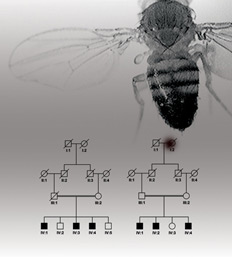Research
July 6, 2011
Mutant flies shed light on inherited intellectual disability

The flies can't hold their wings tightly against their bodies, and have trouble flying and climbing, because they have mutations in a gene called dNab2.
Clumsy fruit flies with poor posture are helping an international team of scientists understand inherited intellectual disability in humans – and vice versa.
The flies can't hold their wings tightly against their bodies, and have trouble flying and climbing, because they have mutations in a gene called dNab2. In humans, mutations in the same gene (with a clunkier name, ZC3H14) have been found to cause intellectual disability (ID) in studies of some Iranian families. ID describes the condition that was previously called mental retardation.
The protein encoded by Nab2/ZC3H14 appears to be part of a group of proteins, including the one disrupted in fragile X syndrome, that regulate brain cell function by binding RNA.
Cross-species comparisons of Nab2/ZC3H14's function are shedding light on how brain cells regulate genes by controlling the length of their RNA "tails." The results are published online in this week's Proceedings of the National Academy of Sciences Early Edition.
The collaboration for this study brought together investigators from Emory School of Medicine, the Max Planck Institute for Molecular Genetics in Berlin and the University of Social Welfare and Rehabilitation Sciences in Tehran.
The paper's co-first authors are Emory graduate student Chang Hui Pak and Max Planck postdoc Masoud Garshasbi, with senior authors Andreas Kuss, group leader at the Max Planck Institute and now at the University of Greifswald, and Anita Corbett, professor of biochemistry and Ken Moberg, assistant professor of cell biology at Emory School of Medicine.
At Emory, Corbett had studied Nab2 in yeast since the 1990s. Her laboratory teamed up with Moberg to look at the function of the gene in fruit flies. Pak, a student in both Corbett's and Moberg's labs, generated flies with mutations in dNab2.
What made those flies easy to spot, next to regular flies, was that the mutant flies kept their wings stretched out. Healthy flies hold their wings folded together over their bodies. Several mutations that affect nerve or muscle development display this "wings held out" effect in flies, Moberg says.
"At this point, we didn't know if it was a problem with the muscles connected to the wings, or with the nerve networks that control those muscles," he says.
Unexpectedly, Corbett received an email in 2009 providing a flash of insight. The German/Iranian team had been studying families in Iran in which cousins marry. They have been looking for genetic mutations that lead to intellectual disability, in a large scale collaboration initiated by Hossein Najmabadi in Tehran and H.-Hilger Ropers in Berlin.
"It has been more straightforward to find mutations that cause ID along the X chromosome, because they show up easily in boys – and they don't need to have inherited the defective genes from both parents," Moberg says. "Studying these families with blood-related parents is a way to explore new ground and learn more about genes on other chromosomes that can be linked to ID."
The Berlin/Tehran team had found that a mutation in the ZC3H14 gene showed up in two independent family trees affected by intellectual disability. Affected individuals can be male or female and have "non-syndromic" intellectual disability, meaning that they don't have altered anatomical development or other features such as autism.
At Emory, scientists are studying the mutant flies to figure out more precisely what's wrong with them: which cells in the fly's brain are affected and what genes and processes go awry in these cells. Although the overall structure of the brain and nervous system in mutant flies looks OK, preliminary evidence suggests the mutation alters structures in the brain important for learning and memory. Emory professor Gary Bassell is collaborating with Corbett to engineer mice lacking the ZC3H14 gene.
"Although mice may better reflect the human situation, exploring the function of Nab2 in flies first allowed us to be quicker and nimbler in designing experiments," Moberg says.
The German/Iranian team is now examining how common mutations in ZC3H14 are in population groups outside Iran, and whether it can account for other forms of intellectual disability.
The research was supported by the National Institutes of Health, the German Federal Ministry of Education and Research, the Max Planck Innovation Fund and the Iranian National Science Foundation.
